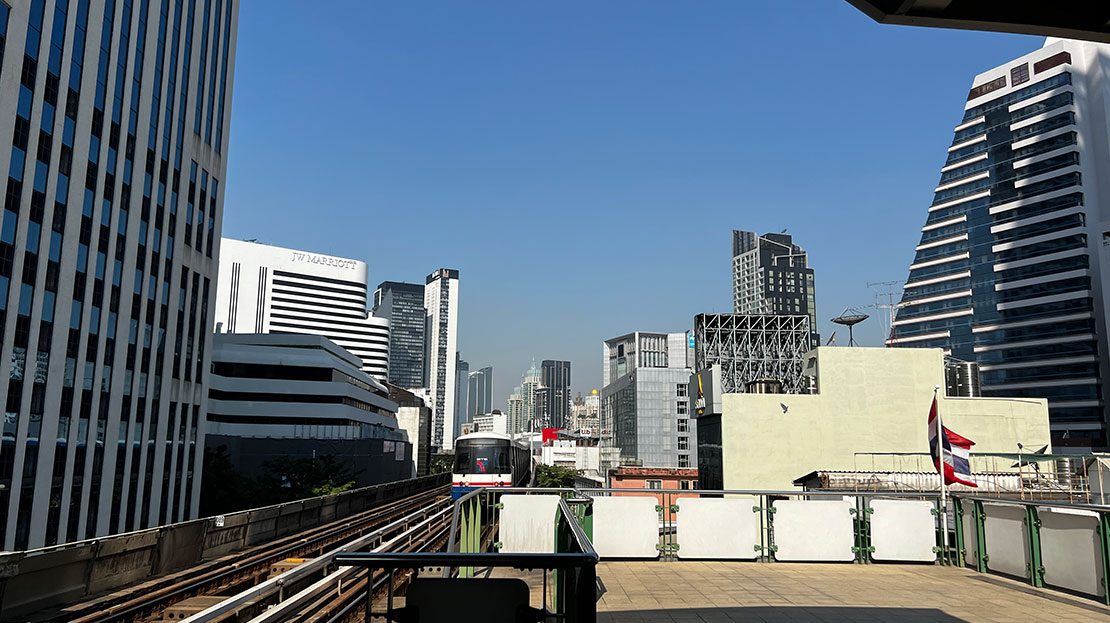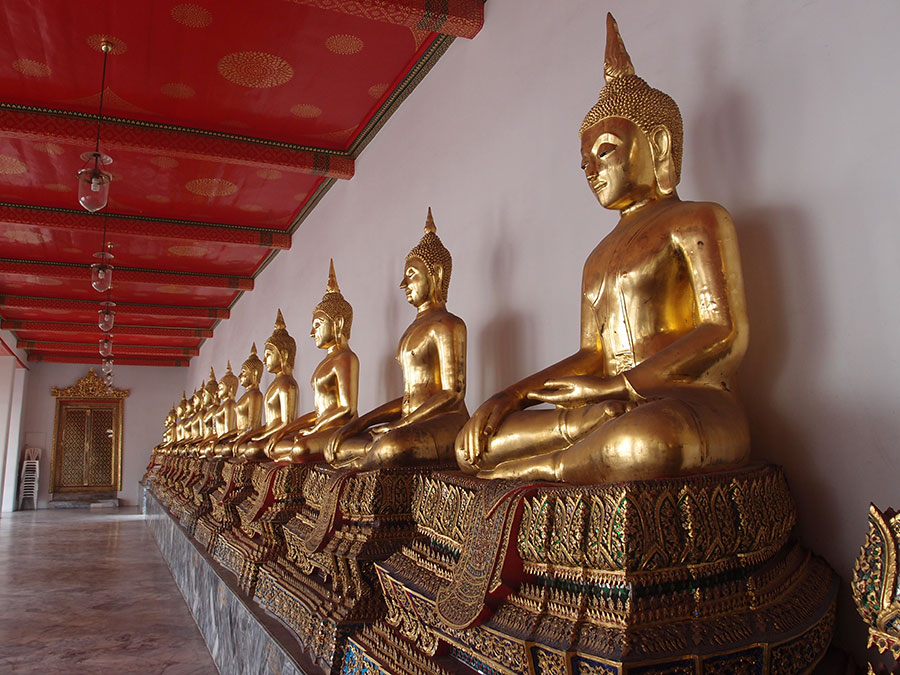Bangkok
If you count the suburbs, Bangkok has close to 10 million inhabitants. Here, in a teeming metropolis that always seems to be on the move, ancient temples rest in the shadow of ultra-modern shopping malls, here skyscrapers coexist with simple sheds and restaurants with fast food joints. There is no obvious centre, but the city consists of several parts that have developed gradually.
Bangkok is quite young as the capital of Thailand and that has its historical explanation. In 1767, the Burmese attacked and left the 400-year-old city of Ayutthaya in ruins. General Taksin, who survived the war against the Burmese, managed to establish a new capital further south along the river. That area is today called Thonburi and is a district of Bangkok. In 1782 Thailand’s first king was crowned; Rama I He built the royal palace using original stones from Ayutthaya. Rama I called the city Krung Thep Maha Nakhon which is only the first words of a 165 letter long name. Today, only Krung Thep, which means the city of angels, is used.
Suvarnabhumi International Airport
Bangkok’s new airport is one of the world’s ten largest with a capacity of just under 45 million passengers. The new major airport is located 30 km southeast of Bangkok and has replaced Bangkok’s previous international airport, Don Muang. It now only takes 1.5 hours by taxi to Sabai Village. (Expect a price around SEK 300) Communal transport is also convenient, but then expect a three-hour journey. (Bus towards Pattaya and then on to Huai Yai, about 25 Sek in total)
Central World Trade Center
Here you will find most things when it comes to shopping. CWTC is several stories high. On the ground floor, various vendors have their stalls and here you should haggle at least 50 percent of the price. Inside the department stores, there are fixed prices, but you can trust that you are getting the real thing.
There is also a skating rink inside the CWTC. All taxi drivers go to CWTC but you can also take the skytrain here. If you ride the skytrain, get off at Chit Lom station and walk north a bit, then cross the street.
MBK – Ma Boon Krong Centre
MBK is like a multi-storey department store with a market feel and somewhat lower prices than other department stores. Here you will find clothes, electronics, leather goods and handicrafts. The restaurant level on floor 6 has a coupon system. Cheap and good!
Traffic in Bangkok
There are a lot of cars and motorcycles in the capital. For a few years now, Thailand has had a strong focus on environmental issues. Therefore, tuk-tuks are not allowed to drive on the main streets, but only on the small side streets. The construction of special motorways has partly reduced traffic in and near the city centre, partly reduced exhaust gases. As a pedestrian, you should pay attention. Keep in mind that traffic in Thailand is on the left. It is safest to cross the street at pedestrian crossings with traffic lights or to find a footbridge. Watch out for the motorcycle messengers who sometimes break traffic rules! Taxis are everywhere. Always ask for a taxi meter (it should start at 35 baht). It’s better than a fixed price as you don’t know how far it is to where you’re going. The drivers usually speak English.
Hua Lumphong – Bangkok Railway Station
As a tourist in Bangkok, Hua Lumphong is the best train station to depart from. It is centrally located and from there you can reach all of Thailand. You can choose to go express and arrive faster or roll along slowly and enjoy the view. Both sleeper and seat trailers are available. The trains have fans and toilets. Train hostesses offer the opportunity to purchase refreshments. Traveling by train is cheap and since the train service is well developed, it is a good way to get around. BTS Bangkok’s SkyTrain.
Open from 06:00 to 24:00 The Bangkok Train System (BTS) operates two lines; one along Sukhumvit Rd and the other along Silom Rd. Taking the skytrain in Bangkok is much more expensive than taking the buses, but it’s easy and fast. Now there is also a nice subway in Bangkok to get there faster and avoid the car traffic.
Life by the canal
If you go out on the canals, you will see a lot of genuine Thailand and how the ordinary Thai lives and lives. The children bathe, play and wash themselves in the canal water while the women wash dishes in it. The men go shopping in the family boat.
There are many fine old teak houses and temples along the edge of the canal, but also some new buildings. It is popular and expensive to live along certain canals.
Canal boats on Khlong San Sap
Khlong is the Thai word for canal. Bangkok’s canal system is complex and extends well outside the inner city. The Khlongs were the transport routes that existed in the old days. Therefore, it can be nice to go on a trip by canal boat or with the faster longtail boat. If you’re really lucky, you’ll witness a genuine floating market. Breeders and growers gather to sell their harvests of fruit, vegetables as well as eggs, meat etc.
Longtail boat on the Chao Phraya
Chao Phraya is the name of the river that runs through the center of the city. There are organized boat trips on the river with lunch/dinner but you can also hire your own longtail boat with a driver for a couple of hours. Often they have special routes with stops along the way at certain attractions. Behind the Oriental Hotel, right down by the river, you can rent longtail boats. Be sure to haggle over the price!
Chatuchak Weekend Market
Bangkok’s big weekend market. A gigantic area which is divided into a number of smaller areas based on the different goods. There are maps of the market so you don’t have to wander around helplessly. At Chatuchak you will find most things. Pets, food, fabrics, flowers, clothes, furniture, etc. Take the skytrain here on a Saturday or Sunday. Get off at the final station Mo Chit and follow the stream the last bit. Open every weekend 9am to 6pm Everywhere in Bangkok you can shop and eat street food. Also by the motorways and next to the train stations, people cook and sell small bags of ready meals to those on their way home from work. In the banking district on Silom Rd (near the Naratiwat Ratchanakarin intersection) there is a food market that is very popular with Thais at lunchtime. Feel free to visit it and feast on good and cheap food.
The Oriental Bangkok
One of the top hotels in the world. Beautifully located by the river. Feel free to have lunch or dinner at Café Oriental with a view of the river. The barbecue buffet in the evening is recommended. If you have a big budget and want to eat first-class French, you should book a table at the top of the Normandie restaurant. Restaurant Lord Jim’s a bit down has more affordable prices. Finish with a drink and live jazz at the Bamboo Bar. Hotel Oriental has a long history. The old part is from the 1920s and has colonial decor. Feel free to look in there and experience the atmosphere. At that time, state visits and royalty were received here.
Grand Palace
Remember to have covered heels, above-the-knee and long-sleeved clothing when visiting the Royal Palace. Show respect, i.e. be quiet, and take off your shoes if you enter a temple. Wat Phra Kaeo (Temple of the Emerald Buddha) is located on the palace grounds and is worth a visit. The small Buddha statue, which was found in Chiang Mai in 1464, has its gem costume changed by the king when a new season begins, i.e. three times a year. Wat Po (Temple of the Reclining Buddha) is just south of Wat Phra Kaeo. Wat Po is one of Bangkok’s oldest and largest temples. Traditional medicine and meditation are practiced and taught here. The giant reclining Buddha statue is truly impressive. Wat Traimit (Temple of the Golden Buddha) is a 5.5-ton golden Buddha statue. It was found by chance inside a larger statue. It dates to the Sukhothai period and was probably hidden from the Burmese when they invaded Ayutthaya. You can find Wat Traimit in Chinatown, on Yaowarat Rd.
Wat Arun in Thonburi
Wat Arun means Temple of the Dawn. It is a magnificent temple decorated with colorful porcelain ceramics. Wat is the Thai word for temple. There are many temples in Bangkok. The good Buddhist goes here every Sunday with flowers and food for the monks. They light incense and show their respect to the Buddha, the monks and their ancestors.
Religion is ever-present in Thailand. It is woven into the most everyday tasks. A Thai likes to stop and light incense at a temple on his way to work. If you take a taxi, you will notice that the driver has a wreath of lotus flowers hanging from the rearview mirror. He asks for luck and good earnings in his professional practice. In his own plot, a Thai always builds a small altar to honor the ancestors. They put food and flowers there every day and hope in this way to bring happiness and luck to the place and their life there. You can see many of these altars everywhere in Bangkok, even on the street. A new building in a public place also requires an altar. Sukhumvit is teeming with bars, restaurants, artisans and all kinds of shops. Late into the night, an extensive street trade is also carried on, which soon occupies every centimeter of the sidewalks. A little more luxurious is Silom Road, which starts at Lumpini Park, and which has been transformed into Bangkok’s main tourist street with hustle and bustle around the clock. Everything from pirated perfume to fake samurai swords is sold here. In addition, some important cross streets start from Silom Road, including Patpong and Convent Road. Where Silom Road ends, by the river, New Road takes over with lots of small shops, artisans and some restaurants. After another bit, the street changes its name to Yaowarat Road which is the main street in Chinatown, with delicious Chinatown and extensive folk life. Chao Praya is Bangkok’s mighty river (and the best benchmark for lost tourists). Along the river are rows of mighty luxury hotels. Thonburi, on the other hand, is a part of Bangkok that tourists rarely visit. Khao San Road is the city’s main backpacker street. All backpackers find their way here.



